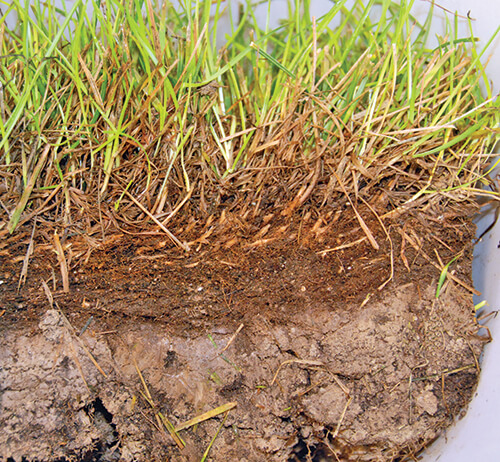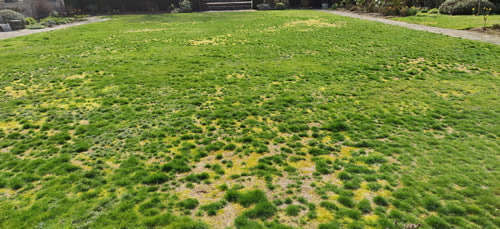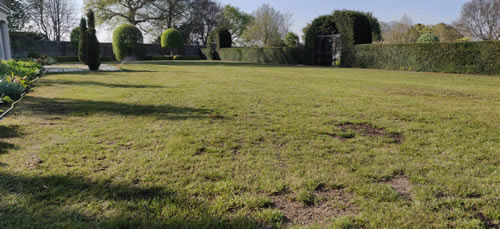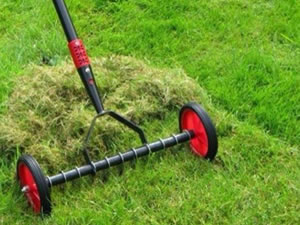Why reduce thatch in my lawn?
- Dethatching your lawn will boost soil biological activity creating better conditions and healthier grass
- Excessive lawn thatch can prevent essential moisture, nutrition and oxygen from entering the soil
- Lawn diseases, such as red-thread and fusarium patch are more likely to affect lawns with an excessive dead thatch layer
- Acting like a sponge, lawn thatch can soak up water before it reaches the soil and root-zone, creating drought issues even in damp conditions
Once excessive lawn thatch has been identified as a problem with your lawn it should be dealt with promptly through dethatching to aid quick recovery.
What causes lawn thatch problems?
How can I deal with thatch in my lawn?
How can I prevent lawn thatch?
Lawn thatch briefly explained…
- Certain grass types are more likely to cause excessive thatch problems
- Excessive fertiliser application is a major contributor to thatch issues
- Cultural work with scarification and aeration will break down thatch
- Boosting soil biology and microbial activity will help prevent thatch problems

Soil sample with layer of surface thatch
What is surface thatch and where does it come from?
This is a layer of dead organic matter laying on the surface of your lawn soil, in the area where the roots of grass meet the leaves of the grass. It is made up of dead grass, stems, plant leaf and shoots/runners from the natural growth of lawn grasses.
When is thatch not a problem?
Thatch in itself is not always a bad thing as it plays an essential role in the health of your lawn. A small layer of thatch, which is moist and has an active population of soil microbes, is a normal part of grass growth. It will help to insulate the soil which also prevents it from drying out excessively during summer months. It can also prevent the lawn from becoming muddy and creates a nicer surface for feet and bottoms!
Why is lawn thatch a problem?
When a thick thatch layer builds up in lawns it can create serious lawn issues. Certain lawn pests such as leatherjackets and chafer grubs like a thatchy lawn environment. These grubs can destroy your lawn by eating roots and shoots. In addition, surface thatch can prevent water and nutrients from reaching the roots of your grass, making it much harder to create a healthy lawn.
What is sub-surface thatch?
This is thatch in the soil of lawns, typically below the grass roots. Because it is within the soil its more difficult material to deal with than thatch on the surface that can be removed with a rake or scarifier. This can have a serious impact on the turf as it prevents roots growing deep into the soil.
Lawn thatch and diseases
A thick layer of thatch in turf can also act as a sponge, soaking up water before it has chance to reach the root-zone and causing drought stress to your grass plants – stressed grass is more susceptible to diseases. The pathogens that cause common lawn diseases such as red-thread and fusarium patch often sit dormant in thatch, once conditions are right these diseases will attack your grass plants – thatchy lawns are more likely to suffer from disease issues.
Thatch, nutrition, and drought problems
A thick layer of thatch will make it harder for nutrition to reach the roots of your grass plants, often resulting in nutritional deficiency. Weaker grass is more susceptible to disease and die-back. In turn these dead areas allow space for moss and weeds to take hold in your lawn. Thatch can also create a hydrophobic layer on the surface of your lawn, meaning that water runs off, rather than into the surface, making it almost impossible to get moisture to the roots.
Is my grass causing thatch in my lawn?
Some grass types are more likely to contribute to surface thatch issues. Bents and fescues with creeping growth habits that put out runners across the surface of the lawn do tend to need more cultural intervention to prevent the build-up of thatch
Does mulch mowing cause lawn thatch?
Leaving green grass clippings behind rather than removing them to compost could eventually be related to a thatch problem. However, many articles online will advise of the beneficial advantages to mulch mowing. Provided clippings are not excessively long and allowed to leave a thick layer on the surface that smothers the turf, they will make a healthy contribution to nutrients. These dead grass clippings, left behind by the mower, are pulled down by insects into the top few inches of soil and as they are broken down by soil microbes they help to reduce the need for fertiliser.
How to prevent lawn thatch
- Identify your grass types, if you have a lot of bents and fescues then verticut/scarify/dethatch your lawn regularly to prevent excessive build-up
- Promote healthy soil practices to boost beneficial microbes which will break down organic matter
- Aerate your lawn at least every year
- Be careful not to apply too much nutrition – excessive growth means more thatch problems
- Don’t let your lawn grass die back through drought or waterlogging – dead leaves add to thatch problems
How to remove thatch from a lawn
Here are the best ways to remove thatch from lawn.
- In autumn or spring, dethatch your lawn with a rake or a machine to scarify the surface of the lawn to keep it under control
- Aerate the lawn to ensure it is not compacted and to allow air and water into the thatch layer
- Boost microbial activity in the ground to aid the natural break-down of the organic matter
- Maintain healthy moisture levels
- Ensure the grass is receiving the correct nutrition to aid recovery

Lawn killed by thatch

Thatch removal lawn recovery

 Established 2016
Established 2016




